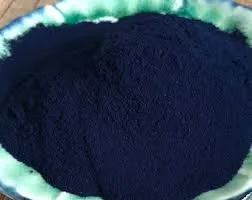high quality indigo dye chemistry
The Chemistry of High-Quality Indigo Dye An Exploration
Indigo dye, revered throughout history for its deep blue hue, has captivated artists, textile manufacturers, and scientists alike. The journey of indigo from plant to fabric is a complex interplay of natural chemistry, cultural significance, and innovative technology. Understanding the chemistry behind high-quality indigo dye not only unveils the secrets of its production but also highlights the notion of sustainability in modern textile applications.
Historical Context
Indigo dye has been used for thousands of years, with its origins tracing back to ancient civilizations in India, Egypt, and China. Traditionally derived from the leaves of the Indigofera plant family, this dye was prized for its vibrant color and remarkable lightfastness. Over the centuries, as industrialization took hold, synthetic alternatives emerged, yet the quest for genuine indigo, particularly in artisanal contexts, has remained vital due to its environmental benefits and cultural heritage.
The Chemical Structure of Indigo
The chemical composition of indigo is primarily categorized as an indole alkaloid. The molecular structure of indigo (C₁₆H₁₀N₂O₂) consists of two indole units joined by a carbon-carbon double bond, which provides the deep coloration associated with the dye. The chromophore system — the part of the molecule responsible for its color — plays a critical role in determining the intensity and quality of the dye. The ability of indigo to absorb light in the visible spectrum results in its characteristic blue shade.
Indigo is insoluble in water, which presents unique challenges in dyeing processes. However, this property also contributes to the dye's lightfastness and long-lasting color when properly treated. The reduction of indigo to its soluble form, leucindigo, is a key step in the dyeing process.
The Reduction Process
The reduction of indigo to leucindigo involves a chemical reaction that incorporates either a reducing agent or an anaerobic environment. Traditionally, natural reducing agents like glucose, sucrose, or even certain composts are used alongside alkaline solutions (often made with lime or ash) to shift the indigo into its water-soluble form. This crucial step allows the dye to be easily absorbed by the fabric.
Upon immersion in the reduced indigo solution, the dye penetrates the fibers of the textile. Once exposed to oxygen, the dye oxidizes, reverting back to its insoluble form and binding to the fabric. This transformation underlines indigo’s duality — its ability to be both a reactive chemical compound and a stable dyed material.
Quality Factors in High-Quality Indigo Dye
high quality indigo dye chemistry

Several factors influence the quality of indigo dye
1. Purity of Raw Materials High-quality indigo begins with pure plant material or high-grade synthetic indigo, free from impurities that might alter the color or stability.
2. Dyeing Technique Artisanal methods often yield richer colors. Techniques such as traditional vat dyeing may enhance color depth and evenness compared to mass-produced methods.
3. Environmental Conditions Factors such as temperature, humidity, and the duration of dyeing impact the final coloration. Experienced dyers often tailor conditions to optimize the characteristics of indigo.
4. Post-Dyeing Treatments Proper washing, fixing, and finishing processes ensure that colors remain vibrant and resistant to fading. Treatments like mordanting can also affect color richness and longevity.
Sustainability and the Future of Indigo Dye
As the fashion industry increasingly acknowledges the detrimental impact of synthetic dyes on the environment, the resurgence of indigo dye, particularly in its natural form, is significant. Plant-based indigo not only boasts bio-degradability but also supports local economies through traditional farming practices.
Innovations in research are aimed at enhancing the sustainability of indigo production, exploring renewable resources, and developing new, more efficient dyeing technologies. Sustainable practices, such as water recycling and the use of organic materials, are becoming integral to modern indigo dyeing techniques.
Conclusion
The chemistry behind high-quality indigo dye is as rich and complex as the hues it produces. From its ancient roots to modern applications, indigo remains a symbol of cultural identity and artistry. As we delve deeper into its chemical properties and sustainable practices, indigo will undoubtedly continue to inspire creativity while promoting environmental consciousness in the textile industry.
-
The Timeless Art of Denim Indigo Dye
NewsJul.01,2025
-
The Rise of Sulfur Dyed Denim
NewsJul.01,2025
-
The Rich Revival of the Best Indigo Dye
NewsJul.01,2025
-
The Enduring Strength of Sulphur Black
NewsJul.01,2025
-
The Ancient Art of Chinese Indigo Dye
NewsJul.01,2025
-
Industry Power of Indigo
NewsJul.01,2025
-
Black Sulfur is Leading the Next Wave
NewsJul.01,2025

Sulphur Black
1.Name: sulphur black; Sulfur Black; Sulphur Black 1;
2.Structure formula:
3.Molecule formula: C6H4N2O5
4.CAS No.: 1326-82-5
5.HS code: 32041911
6.Product specification:Appearance:black phosphorus flakes; black liquid

Bromo Indigo; Vat Bromo-Indigo; C.I.Vat Blue 5
1.Name: Bromo indigo; Vat bromo-indigo; C.I.Vat blue 5;
2.Structure formula:
3.Molecule formula: C16H6Br4N2O2
4.CAS No.: 2475-31-2
5.HS code: 3204151000 6.Major usage and instruction: Be mainly used to dye cotton fabrics.

Indigo Blue Vat Blue
1.Name: indigo blue,vat blue 1,
2.Structure formula:
3.Molecule formula: C16H10N2O2
4.. CAS No.: 482-89-3
5.Molecule weight: 262.62
6.HS code: 3204151000
7.Major usage and instruction: Be mainly used to dye cotton fabrics.

